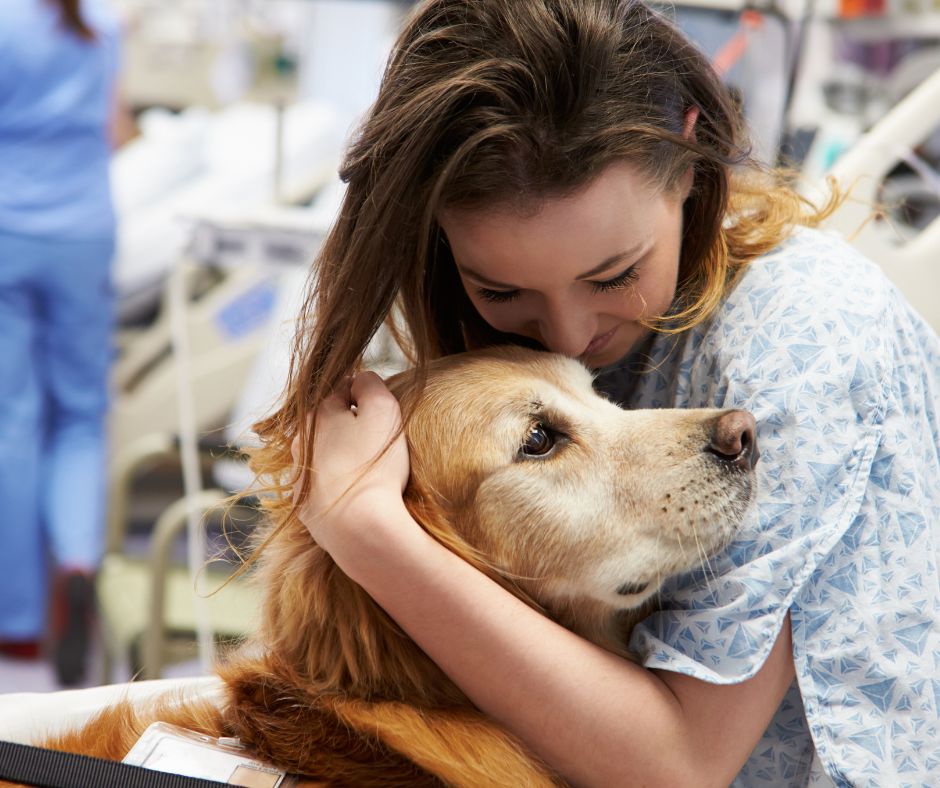By Alejandra Viviecas, PhD
Being considered a major life stressor, cancer may cause substantial psychological distress.1 Adopting strategies to manage this burden within cancer centers is therefore essential.2 Interacting with pets can improve the mental health and quality of life of patients with cancer and reduce the stress associated with treatment.2-3 Recognizing these benefits, several cancer centers have introduced programs that facilitate this interaction. To learn more about these initiatives, The Oncology Connection interviewed Helen Gordon, CAVS, CPXP, who has directed the volunteer services at Fox Chase Cancer Center in Philadelphia for 11 years. Helen is a member of the Pennsylvania Association of Directors of Volunteer Services in Healthcare, Inc. – Eastern Chapter and the Society for Healthcare Volunteer Leaders.
The Oncology Connection: Can you share what prompted the start of the pet visitor program at Fox Chase Cancer Center?
Helen Gordon, CAVS, CPXP: The program aims to fulfil the needs of patients with cancer. They are coping with the burden of a cancer diagnosis and any connection, human or with dogs, can ease the stress and strain they experience. Patients may have left pets at home, so they often welcome a visit from our pet volunteers.
The Oncology Connection: What is the current size of your therapy dog team, and what standards must they meet?
Gordon: We have eight dogs and seven handlers. My goal is to have at least 10 dogs so we can schedule two dogs each weekday: one in the morning and one in the afternoon. Two dogs are currently applying, so I’m close to reaching that goal.
All pets must be certified as therapy dogs. We also ask for veterinary records and proof that they are staying current with those requirements. The dogs must be clean and bathed before they come. Handlers must provide medical documentation and go through health screenings.
The Oncology Connection: What does the pet therapy certification entail?
Gordon: Pet certification groups train the dogs to behave appropriately in healthcare settings. These dogs become accustomed to the unique smells, sounds, and characteristics of a cancer center.
Although our dogs are certified for therapy, we call them pet visitors since the Joint Commission accrediting our hospital defines “therapeutic dogs” as these actively participating in patient therapy. Our pets visit with patients and spread joy. It’s not official therapy.
The Oncology Connection: How does a pet visit occur?
Gordon: The dogs sign in at our office when they arrive. They spend 1 to 2 hours visiting the center and sign out before leaving.
During the visits, the dogs and their handlers go to the public and waiting areas. They stop at the nurses’ station on each floor to ask if someone wants a visit. Patients can also request visits by calling our office. We even created trading cards for the dogs and people collect those and call us asking for visits from specific dogs.
The Oncology Connection: Are there any restrictions for these visits?
Gordon: The dogs are not allowed to go in the infusion room or any treatment areas. Most of our dogs can go into the patients’ rooms upon request, but they spend most of the time in the waiting rooms and hallways. Patients in precaution rooms, who might have a contagious illness, cannot get visits to ensure the safety of the handler and the dog.
The Oncology Connection: What does an interaction look like?
Gordon: We have had dogs get up in bed with patients, search them in the waiting rooms, or play with patients and family members. Our handlers tell us that the dogs are very intuitive and know who in the room might need them the most, and they seek them out.
We had a memorable interaction with a young father and his family. The dog went into the room and played with the children. Then the man, who was very ill, asked for the dog. So they allowed the dog onto the bed, where she laid her head on the man’s shoulder for approximately 45 minutes. He passed away the next day and really wanted that visit.
The Oncology Connection: Have you encountered any challenges since starting the program?
Gordon: The main challenge is recruiting enough pet volunteers. Certifying dogs is not inexpensive and Fox Chase Cancer Center is an international, well-renowned cancer center. Our patients and volunteers sometimes travel hours to get here.
During COVID, all the volunteers were sent home and many of our pets retired or passed away. When we decided to restart the visits, we had one dog left. Finding people with already certified pets was challenging. Luckily, I found a conference for pet certification groups. I reached out to the organizers, and they put me in touch with people who referred new volunteers, and they spread the word.
The Oncology Connection: What are the benefits of the program for those involved?
Gordon: The stress relief the pets provide is incredible. It’s hard to measure, but it brings smiles to people’s faces. They stop right in their tracks when they see a pet coming. So, we know it’s important to them.
A few years ago, a patient saw one of our dogs while walking down the hallway. She fell onto the floor with him, started crying and hugging him. Then, she got up, wiped her tears, and said: “That’s what I needed today to finish my treatment.” We were crying witnessing that interaction.
Our colleagues benefit as well. Working in a cancer center, our staff deals with a lot of stressful situations, emotion, and illness. We tend to be very reserved, but that changes with the dogs. We see nurses running down the hallway to greet them. Carol, who works in the volunteer office, is close with some of the dogs, and even our COO came in to pet a dog the other day.
Finally, our pet parents take great pride in their dogs. Many of them are survivors, relatives of survivors, or know someone who was treated here and want to share something they love with others who will benefit from it. They have a calling to help reduce the burden of cancer.
References
- Wang, Y., & Feng, W. (2022). Cancer-related psychosocial challenges. General psychiatry, 35(5), e100871. https://doi.org/10.1136/gpsych-2022-100871
- Holder, T. R. N., Gruen, M. E., Roberts, D. L., Somers, T., & Bozkurt, A. (2020). A Systematic Literature Review of Animal-Assisted Interventions in Oncology (Part I): Methods and Results. Integrative cancer therapies, 19, 1534735420943278. https://doi.org/10.1177/1534735420943278
- Bert, F., Gualano, M. R., Camussi, E., Pieve, G., Voglino, G., & Siliquini, R. (2016). Animal assisted intervention: A systematic review of benefits and risks. European journal of integrative medicine, 8(5), 695–706. https://doi.org/10.1016/j.eujim.2016.05.005







